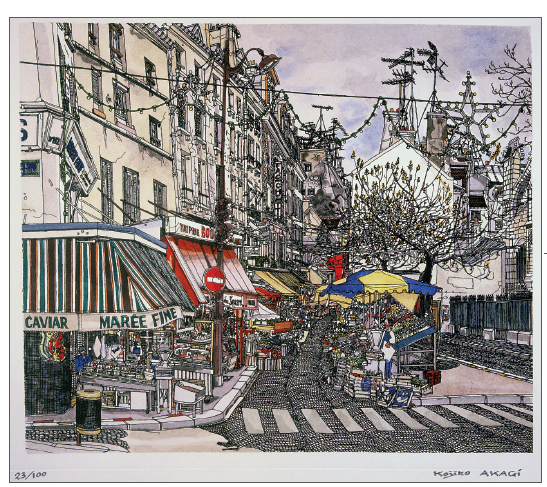Marché de la rue Mouffetard / Rue Mouffetard Market / ムフタール通りの市場
Dublin Core
Title
Marché de la rue Mouffetard / Rue Mouffetard Market / ムフタール通りの市場
Subject
Marché, Rue, Gravure, Pochoir
Description
En descendant la rue Descartes en direction du sud, on arrive à «La Mouffe». C’est une vieille rue où perdurent un peu partout de vieilles enseignes de commerces qui attirent l’attention des touristes et des historiens. Un marché se tient tous les jours dans cette rue étroite et populaire. L’église Saint Médard, à droite derrière l’illustration, date du 15e siècle. À cette époque, l’endroit était un village de la banlieue parisienne. Le bâtiment actuel a été achevé en 1655. C’est ici qu’est mort le vicaire de Paris en 1727. Vénéré comme un saint, il est enterré dans le cimetière derrière l’église. Selon la croyance populaire, il suffisait de toucher sa tombe pour se guérir d’une maladie. Cette légende s’étant répandue, les gens venaient en foule sur sa tombe. Pour mieux connaître ce quartier, je vous conseille de lire «Les Misérables» de Victor Hugo, car c’est le quartier où vit Jean Valjean secrètement avec Cosette. Victor Hugo y décrit si bien le quartier de cette première moitié du 19e siècle que l’on peut tout retrouver sur les plans. Je suis même surpris de toutes les précisions.
If you head down Rue Descartes to the south you’ll reach this street. Because it’s old, signboards from the past remain on some shops, of interest to researchers of history and tourists.The market held every day in the narrow street is also popular and, visible on the right, Eglise Saint-Médard is a church from the 15th century when it was a suburban village. The current building was completed in 1655. The assistant priest Paris, who was worshipped as a saint here, passed away in 1727, buried in the graveyard at
the back. The belief that if sick and crippled people could be miraculously cured if they touched the tombstone spread so people flocked in here, making it famous.To find out more about this vicinity it is the best to read Victor Hugo’s “Les Misérables” because Jean Valjean lives with the orphan Cosette here in secret. You can trace this story, which was set first half of the 19th century, in surprising detail on a map. I am rather amazed with its accuracy.
the back. The belief that if sick and crippled people could be miraculously cured if they touched the tombstone spread so people flocked in here, making it famous.To find out more about this vicinity it is the best to read Victor Hugo’s “Les Misérables” because Jean Valjean lives with the orphan Cosette here in secret. You can trace this story, which was set first half of the 19th century, in surprising detail on a map. I am rather amazed with its accuracy.
デカルト通りを南に下ると、この通りに続く。古い通りなので、商店に昔の看板が残っているところが各所にあって、歴史研究者やツーリストの興味を引く。 狭い道に毎日出る市場も人気で、右手後ろのサン・メダール教会は、十五世紀からつづく、昔の郊外村だった時代からの教会堂で、一六五五年に完成している。ここで聖者と崇められたパリスという助司祭が、一七二七年に亡くなって、裏の墓地に埋葬され、その墓石にさわると病気や不具者が治る奇跡が起きるという信仰が広まって、人々が押しかけて有名だった。 この界隈については、ビクトル・ユーゴーの「レ・ミゼラブル」(ああ無情)を読むのが一番いい。ジャン・バルジャンが孤児のコゼットと隠れ住むので、詳細に十九世紀前半の頃の様子が、地図でたどれる。むしろ正確さに、驚かされる。
Creator
Kojiro Akagi (1934-2021)
Date
Avril 1994 / April 1994
Rights
Fonds de dotation Kojiro AKAGI
Format
Gravure et pochoir, Atelier Garric Tanguy et Atelier Jacomet,
100 tirages + 6 E.A. romain + 9 E.A. peint à la main romain,
+ 5 E.A. gravure romain, sur papier Moulin du Gué 50 x 65 cm.
100 tirages + 6 E.A. romain + 9 E.A. peint à la main romain,
+ 5 E.A. gravure romain, sur papier Moulin du Gué 50 x 65 cm.
Type
Gravure et pochoir
Citation
Kojiro Akagi (1934-2021), “Marché de la rue Mouffetard / Rue Mouffetard Market / ムフタール通りの市場,” Kojiro Akagi - Fonds de dotation Kojiro AKAGI , accessed December 21, 2025, https://kojiroakagi.com/gallery/items/show/97.

